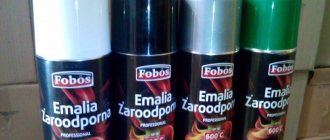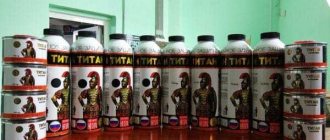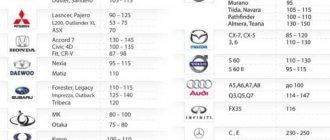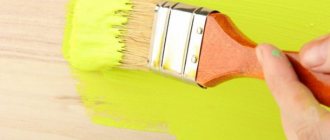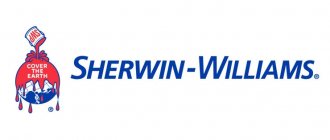Dear friends! Our company decided to sum up the sales results, take into account all the technical knowledge, consumer reviews and the demand for certain product items in the sales of thickness gauges. Based on this data, we conducted a comparative analysis and compiled a fresh, most objective rating of car paint meters for 2020-2021.
Today, the measuring instrument market offers a huge selection of paintwork scanners of various form factors and price categories. But at the same time, there is practically no information or comparative test reviews on the most popular and accessible ones. Therefore, with this article we also want to help future buyers decide which thickness gauge to buy.
So, in our review we will look at 10 thickness gauges costing from 1,400 to 13,000 rubles
, with an adequate price-quality ratio.
How to check a car with a thickness gauge
When determining the thickness of a car's paintwork, you must adhere to the following rules:
- record data on the thickness of the paintwork of each specific car, which can be obtained on the manufacturer’s website;
- the surface of the body must be clean and dry - dust particles will not only interfere with obtaining correct data, but will also damage the paintwork and the sensor of the device;
- The paint thickness gauge must match the body material;
- The device should only be installed on a flat surface;
- The thickness gauge sensor must fit tightly to the body;
- take measurements on the outer and inner parts of the body;
- the number of measurements on each element is at least 3 – 5 depending on the size;
- location of measurement points - along the perimeter of the part and in the center;
- special attention to relief details: take at least 5 - 7 measurements at different distances from the relief in all directions;
- body pillars - at least 5 dimensions;
- If a single deviation in value is detected on one part, take additional measurements of the area.
When taking measurements, the following nuances must be taken into account:
- the thickness of the paintwork on different parts may have factory differences, but the values of the symmetrical sections must be equal;
- permissible factory deviation from the stated standard is no more than 50 microns;
- the thickness of the paintwork on the inside is always less than on the outside, but not more than 50 microns;
- the thickness of the paint on the central part of the roof is always less and is 65 - 130 microns;
- the thickness of the paintwork under the hood is no more than 100 microns;
- the presence of an anti-gravel film increases the value by 90 – 160 microns, depending on the type;
- anti-gravel paint thickness – 120 – 210 microns.
Analysis of the results obtained indicates the following:
- decreasing the standard value by 50 microns – grinding and polishing the scratch;
- exceeding the standard value by 50 microns - repairing, painting or varnishing a minor scratch;
- excess by 200 – 500 microns – filling and repainting of the element;
- an excess of 500 microns or more - a deformed part, a thick layer of putty material, rough painting - this is how cars are restored after serious accidents in order to quickly resell them.
A thick layer of coating is destroyed under vibration and shock loads, cracks, rust and chips appear on the body - such an element cannot be restored again.
Thus, measuring the thickness of the paintwork is a necessary process when buying a used car, since it provides a 100% guarantee of identifying possible damage to the body, which will subsequently lead to corrosion, and, consequently, to repair or replacement of the part, and will also indicate the fact involvement of a car in an accident. If there are doubts about the correct use of the device, you must invite a specialist to evaluate it.
Be careful with AliExpress
For non-professional use, you definitely don’t need a Qnix 4500 for $700-800, but it’s also not worth buying devices for $30 - more on that below.
In Belarusian stores, prices for good combined thickness gauges start at $120-130. They cost about the same on the Russian Ozon.
Most of the devices, of course, are made in China. Structurally, the same models are ordered by different suppliers and sold under their own brands. Visually identical Etari, rDevice, Profiline, etc. with different indexes can be completely identical internally. But their prices are usually the same, plus or minus. If the device looks similar, but costs three times less, it’s worth considering, because we all know that the Chinese price corresponds to the filling. Paid more and got better components, paid little and got cheaper ones.
What if you look for analogues on AliExpress? It's a good idea, you'll probably be able to find them. But you need to carefully read the characteristics and read reviews. After all, you are unlikely to like it if you receive a high-quality and accurate device, but it will show values in microinches (mils) and nothing more.
It’s not worth buying very cheap thickness gauges from Alika. Many of them are capable of displaying results only in those same microinches or fractions of a millimeter. The usual 150 microns are much clearer than 0.15 mm. And some even round up only to tenths. In the end, go figure, 0.2 mm is 155 microns or 240.
In addition, cheap devices have a large error; often they can only be used to reliably establish the presence of putty.
Cheap thickness gauge from AliExpress
In general, there is no point in chasing cheapness. If you don’t want to buy a device for $100 or more, you can rent it – there are plenty of such offers today.
Types of thickness gauges
The decisive role when choosing a paint thickness gauge is played by the body material, since the most common devices are not universal and provide reliable information only when working with specific metals or plastics. In addition, they differ in the physical method of determining the thickness of the coating and the complexity of execution - there are professional models that transmit and save data to a PC or smartphone.
Magnetic thickness gauge
The design of a magnetic thickness gauge is simple: a magnet is placed inside a plastic case. Its operation is based on one of the main properties of a permanent magnet - as you move away from the metal surface, the strength of the magnetic current decreases. The maximum magnitude of the attractive force occurs when the magnet is connected to the metal - this indicator serves as the starting point when calculating the thickness of the obstacle.
The principle of determining the thickness of the coating consists of several stages and is as follows:
- when the magnetic tip of the device comes into contact with the metal base of the body surface, an attractive force arises between them;
- the magnitude of the force is related to the maximum value;
- the deviation value is converted into a digital value;
- The thickness of the car's paintwork is displayed on a dial or electronic indicator.
Advantages of a magnetic thickness gauge:
- measuring the thickness of electrically conductive and dielectric coatings;
- maximum layer of measured coating – up to 2 mm;
- low cost;
- energy independence;
- ease of operation.
Flaws:
- measuring coating thickness on metal surfaces only;
- high degree of measurement error when the magnet tip wears out or becomes dirty;
- possible increase in error up to 5 - 7% due to constant exposure to magnetic field strength.
In addition, it is important to remember that when the device is heated, the magnetic properties are weakened, so its use is only possible at a temperature of +20°C...+23°C.
Electromagnetic thickness gauge
An electromagnetic thickness gauge consists of a coil and a ferromagnetic core, which acquires the properties of a magnet only when electric current is applied to the winding. As a result of the interaction of the device tip with a metal surface, a magnetic field arises, the density of which correlates with the maximum value specified during calibration.
Advantages:
- high measurement accuracy – maximum error is 3%;
- maximum layer of measured coating – up to 2 mm;
- simplicity and ease of use;
- The optimum ratio of price and quality.
Flaws:
- Use only on metal surfaces.
The accuracy of an electromagnetic thickness gauge is higher, since the basis for calculations when using a magnetic thickness gauge is the strength of the magnetic field, which depends on many external factors, and when taking measurements using an electromagnetic device, the density of the magnetic field, which is not constant and occurs only at the moment of measurement.
Ultrasonic thickness gauge
The operating principle of an ultrasonic thickness gauge is based on measuring the time it takes for high-frequency sound to pass through an obstacle and the time it takes to receive an echo signal from the reflected surface. The time period set during calibration is taken as a basis.
Electroacoustic transducers are used as a mechanical source of directional ultrasound, which, under the influence of electric current, emit acoustic waves with a frequency of over 20,000 Hz.
The measurement process looks like this:
- a layer of contact lubricant (special gel, glycerin or oil) is applied to the surface cleaned of dust;
- an electrical voltage is applied to the device applied to the surface being analyzed;
- the current supplied to the converter is generated into an audio signal, which is transmitted through the contact fluid to the working surface;
- ultrasound reflected from the base is returned to the device and transformed into a high-frequency electrical signal;
- the received echo signal is sent to the sensor;
- the time spent is converted into a digital indicator of the thickness of the paintwork, which is displayed on the electronic display of the device.
Advantages of an ultrasonic thickness gauge:
- Can be used on metal, plastic, aluminum, composite, glass and ceramic surfaces;
- use in places with limited access;
- maximum layer of measured coating – up to 3 mm;
- high accuracy - up to 0.001 mm.
Flaws:
- surface preparation and application of contact liquids are required;
- increase in error up to 5% when measuring the thickness of paintwork on metal with traces of corrosion.
Ultrasonic devices are most often used by car service specialists, but, as a rule, there are no difficulties when using them independently.
Eddy current thickness gauge
Eddy closed currents arise in electrical conductors under the influence of a magnetic field that is generated on the winding of an electromagnetic coil when voltage is applied at the moment of approaching the conductive material of the surface.
The starting point when calculating the thickness of the coating is the maximum value of the electric current that occurs when the device’s sensor comes into contact with the metal. The change in voltage indicator directly depends on the distance to the electrically conductive surface.
The thickness of the dielectric paint coating is the resulting value of the current indicator, converted into a digital value in microns - the lower the current value, the more material is applied to the surface of the body.
Advantages:
- high precision when working with conductive surfaces (aluminum or copper);
- the maximum layer of measured coating is up to 1.7 mm.
Flaws:
- limited scope;
- an increase in the error when measuring paintwork on dielectric surfaces by up to 5–7%, depending on the resistance index of the material.
Since the eddy current thickness gauge gives accurate readings only when working with electrically conductive materials, it is advisable to use it in combination with an electromagnetic or ultrasonic device.
Thickness gauge calibration
Thickness gauge calibration is the process of establishing equality between the device’s performance and the actual coating thickness, taking into account the permissible error. It is carried out before the first measurement and then at least once every 3-4 months. It is important to know that the settings may be lost more often if the device is rarely used or stored in an unheated room in winter or, conversely, at high ambient temperatures (above +28°C).
To calibrate the device, two plates are used: one is plastic, playing the role of paintwork, the second is a zero sample made of metal suitable for measurements for each specific thickness gauge.
The process looks like this:
- turn on the device;
- lay the metal plate horizontally;
- press the button intended for calibration;
- install the device on the plate, firmly, but without force, pressing the sensor to the sample;
- reset the received readings;
- place a plastic sample on a metal plate;
- take a measurement;
- Compare the obtained result with the reference value indicated on the plastic sample.
If you receive erroneous data, perform the calibration again. If the result is incorrect data or the error exceeds the standard established by the manufacturer, you should contact a store or service center for help.
Why do you need a thickness gauge?
The thickness gauge is used:
- for professional assessment of the quality of paintwork during painting work;
- to determine the value of a car during examination;
- to identify body damage when purchasing a vehicle.
The thickness of the paint coating applied to the car body depends on the make, model and place of manufacture of the vehicle. Limit values – from 80 to 170 microns. The exact value of each specific car can be found in the operating documentation or on the manufacturer’s official website.
The paintwork of a car that has been in an accident is invariably damaged. Depending on the degree of damage, and, consequently, on the severity of the accident, coating repair includes one or more processes:
- grinding – removing small scratches using an abrasive material;
- straightening – restoration of the damaged shape of a body part;
- puttying - leveling large and medium-sized dents using plastic material;
- priming – leveling small dents, fixing putty;
- coloring – application of paintwork;
- varnishing – fixing paint and adding shine;
- polishing – adding shine.
Thus, the thickness of the coating on a part that has undergone any repairs differs from the thickness of the factory paint. Based on the data obtained using a thickness gauge, you can determine not only the likelihood of damage, but also its degree.
The information obtained will also suggest that the car may have significant internal damage resulting from the accident, which can seriously affect the value of the car. It’s no secret that sometimes damaged cars have their bodies restored to almost perfect condition and they try to sell them without informing them that the car was in an accident.



